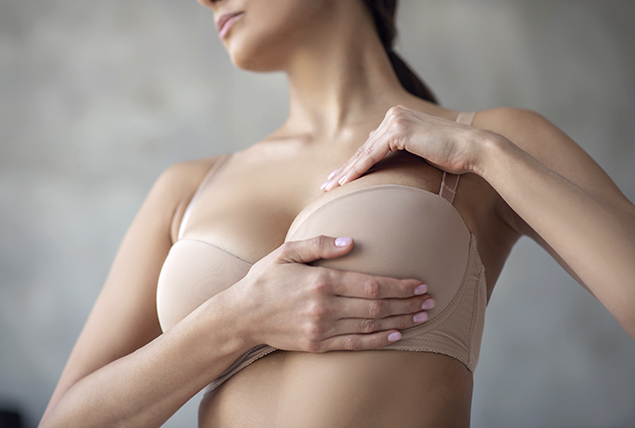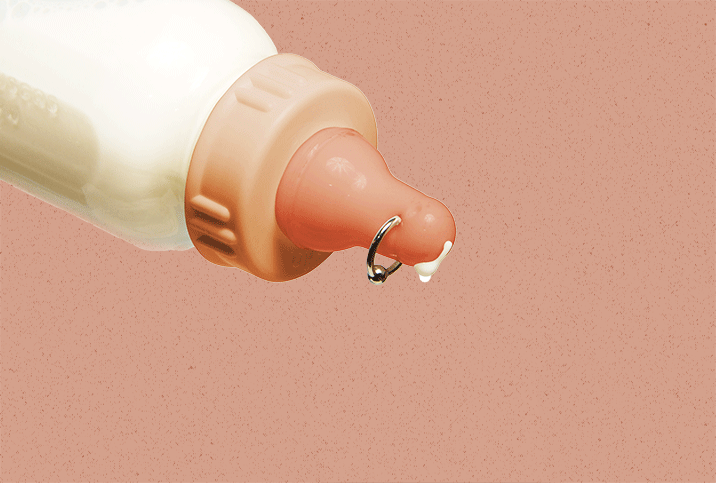The Facts About Breast Health

Few women really understand the composition of their own breasts, but possessing that knowledge can make all the difference in preventing serious breast health issues. Identifying a dangerous abnormality depends on knowing what a normal, healthy baseline is, which depends on getting the facts right about your body.
An overview of the breast
The female breast is composed of multiple tissues, some of which aid in the creation, storage and delivery of milk produced at childbirth to nourish an infant. For example, glandular tissues create the lobules where milk is produced. These lobules are the beginning of a complex network of tubes called the breast ducts, which transport the milk from the lobules to the nipple during lactation.
This complex lactation network is held in place by fibrous connective tissue and is protected and insulated by fatty tissue. The amount and distribution of this fatty tissue determine breast size. In addition to how much tissue is present, the density of breast tissue should be a primary concern when considering breast health.
While breast density has no correlation to breast size, it's believed to be one important factor that determines the risk for breast cancer. Other factors for breast cancer include heredity and family history. The frequency of cancer and genetic mutations, such as those found on the BRCA1 and BRCA2 genes, in your family history are important questions to answer when your physician is assessing your breast health and cancer risk.
Potential breast health complications
Breast health complications are most common during pregnancy and lactation because as the breasts prepare for the delivery of a child and, later, the breastfeeding of that child, hormones fluctuate and internal structures change. The emphasis on breast health during pregnancy tends to overshadow the importance of daily breast care for every woman, regardless of age.
As a result, most women do not realize that daily care can help detect and prevent some common breast health complications that may occur anytime during a woman's life. The following are some of the most common breast complications:
- Breast pain is common before menstruation, typically due to swelling as hormones fluctuate. It can also be caused by noncancerous growths such as cysts and fibroadenomas.
- Cracked nipples often come about as a result of dry skin, which is particularly common during the winter months or in dry climates. This condition is often treated with routine use of moisturizers. However, if you have a skin condition such as eczema or psoriasis, cracked nipples can become more severe, and you may need to seek further medical attention.
- Cysts are areas of fluid, common in any area of the body. Many women experience breast cysts during hormonal fluctuations later in life. The size and number of cysts can vary from woman to woman and can become more painful and troublesome as the size of the cyst increases. Cysts are often benign, but it's still important that a physician properly identify and monitor any you may have in case one is malignant.
- Fibroadenomas are areas of highly dense breast tissue that can affect women at any age and appear in a variety of sizes and compositions. These dense tissue areas can interfere with mammogram findings because they often appear as white areas in the results and resemble lumps. They may also be painful at times during your monthly cycle.
- Nipple discharge was once thought to indicate cancer, but it is actually very common and rarely life-threatening. This can occur when a milk duct becomes blocked by noncancerous growths or by fluid crystallization. If pain or swelling occurs, this may be a sign of an infection, and you should notify your doctor immediately.
Many of these conditions do not require treatment—they can resolve over time—and the best response is often close monitoring and waiting to see how they progress. Know, however, that while it is annoying to put up with the symptoms, these common conditions rarely become cancerous. When a doctor does recommend the removal of any problem tissue causing any of these conditions, it is usually to decrease the patient's pain and improve her quality of life.
It's essential to monitor and document symptoms and schedule an appointment with your physician in order to make sure that your condition isn't something more serious. With regular monitoring, including breast self-exams, you can increase your chances of early detection should one of these common conditions point to a potentially cancerous diagnosis.
Performing regular breast self-exams
Breast self-exams are a powerful diagnostic tool in early cancer prevention. (Many health experts and organizations are dropping breast self-exams from their protocols, and even more are emphasizing that self-exams are an adjunct to, not a substitute for, mammography.) They can be done at any time, but doctors typically recommend performing them once a month. If you have tissue growths or conditions like fibroadenomas, you may be advised to self-examine more frequently to check for any changes. Your physician can advise you about what is best for your breasts.
Performing a breast self-exam is simple, but it requires a specific technique to ensure thorough palpation of the breast tissue. Exams can be performed seated or lying down. When conducting an exam, use the fingertips and move over the entire breast starting at the armpit. Make sure you cover the entire surface by dividing the task into sections of the breast, like pie slices. Repeat palpation three times with varied pressure, from light to firm, and document any dense or bumpy areas of tissue. They may not be signs of cancer but should be disclosed to your doctor. Some women find it easiest to draw diagrams and label the location of any lumps or irregularities in a notebook that they bring to their annual well-woman exam. Once you learn your breast composition with regular exams, you can easily detect and document any changes that should be reported.
It's normal to have some variation in breast tissue, such as the areas that contain the lobules and milk ducts, and there may be places with more dense breast tissue, especially if fibroadenomas are present. However, if these dense areas change in size or shape, or you notice any ridges or puckering in the visual examination, these may be indications of new growths that could be cancerous.
While most of your findings are unlikely to lead to a cancer diagnosis, it's estimated that 40 percent of cancer diagnoses are found after a breast self-exam, so routinely checking your breasts and reporting any changes can improve the prognosis should there be a cancer diagnosis.
The importance of preventive checkups
As helpful as self-exams can be, there is no replacement for yearly preventive checkups. Your OB-GYN is trained in diagnosing irregular findings in breast exams and can provide the most accurate breast evaluation possible. It’s important to make annual exams a priority. Many women, for convenience, schedule these at the same time every year. Keep track of your appointment on a paper calendar or a planner, or save the appointment in the calendar app on your phone. The advantage of recording it electronically is that you'll receive reminders and alerts that the appointment is upcoming.
Sharing the month-to-month changes in your body and health throughout the year can also be a helpful diagnostic tool for your doctor. For example, if you notice a small lump in your breast and your doctor wants you to monitor it, documenting month-to-month changes in size, shape, consistency and location can help your doctor determine if a procedure like a lumpectomy or a biopsy is needed.
As you age, your breast density and composition can change. Noting the changes and discussing them with your doctor is important in determining when you need to start receiving a yearly mammogram.
Recommendations vary widely as to when women should begin getting mammograms, how often and for how long. The CDC has compiled a chart that summarizes the disparate guidelines. The best thing to do is talk with your doctor about the timing that's best for you based on your health history. Your doctor may recommend starting regular mammography earlier, depending on your family history with cancer. In fact, having a first-degree relative who was diagnosed with breast cancer doubles your risk of developing it yourself.
If you have a close relative—mother, aunt, daughter—who was diagnosed with cancer, your doctor may also recommend that you receive genetic testing to determine if you carry a gene mutation associated with breast cancer. If you do, your doctor will develop a preventive treatment plan that could involve more frequent mammograms, breast ultrasounds or even a preventive mastectomy.
How to maintain breast wellness
While there is no definitive way to protect yourself from breast cancer and its complications, a healthy, active lifestyle can help prevent most degenerative and life-threatening diseases, including breast cancer. While it is still the second most common cancer diagnosis among women in the U.S., breast cancer is less deadly than it used to be; deaths have been declining because of increased early detection as well as advances in treatment.
In addition to diagnostics and knowing your risks, you can take control of your health with preventive lifestyle choices, such as limiting alcohol consumption and quitting smoking. Regular exercise is also important to help maintain healthy estrogen levels; high estrogen levels are common with obesity and a cancer diagnosis.
If you don't already practice healthy eating habits, increase your consumption of fresh fruits and vegetables to promote healthy tissue generation and a healthier weight. Reducing stress can also have lasting impacts on your health. Long-term stress is associated with many conditions that can compromise the immune system, which plays a role in developing cancer.
Prolonged stress can increase your chances of indulging in high-risk behaviors, like drinking and smoking, and unhealthy habits, like overeating or eating too much fat and sugar. Stress-reducing activities include regular exercise, getting enough sleep and practicing restorative activities such as meditation. Counseling can help women cope with anxiety and depression, preventing the harmful side effects of stress.
Your contraceptive choices can also impact your chances of developing breast cancer if you are still taking oral contraceptives after age 35. Talking with your doctor about your healthiest birth control options is important in reducing your risks of breast cancer, especially if you end up requiring hormone therapy during or after menopause.
Know your risks
You can follow every guideline for breast cancer prevention and still develop the disease. Because there's no surefire way to avoid cancer, early detection is critical. The best way to protect yourself is to know your body and track any changes—not just in your breasts, but in your whole body. Always call your doctor if you have any questions or if you identify anything out of the ordinary.


















